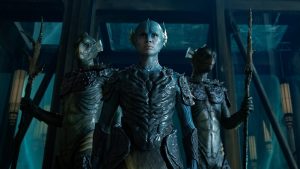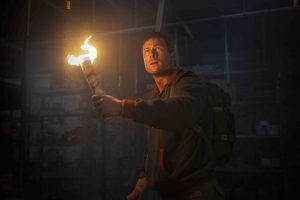
This article contains plot spoilers for Critical Role “Campaign Three: Bells Hells.”
Critical Role’s current campaign, “Bells Hells,” isn’t the first time that inner-party conflict has come up for the cast. Beuregard (Marisha Ray) and Caleb (Liam O’Brien) fought over a magical bowl in The Mighty Nein campaign. Scanlan (Sam Riegel) left Vox Machina for an entire year. But where Bells Hells stands out above the rest is just how often its zany cast of characters find themselves at odds with one another, and how both the cast and the characters handle the conflict.
Bells Hells is certainly the most eclectic group of adventurers that the Critical Role cast has portrayed, and if you’ve kept up with the show for any amount of time, you know that that means this group is really out there. There’s Fresh Cut Grass a.k.a. FCG (Sam Riegel), an aeormaton robot whose programming makes them uncontrollably violent if they get too stressed out. There’s Laudna (Marisha Ray) who was not only somehow brought back to life by Vox Machina villain Delilah Briarwood after being sacrificed by her, but also has to live with her power-hungry influence in her brain. There’s Orym (Liam O’Brien) whose savior-complex occasionally clouds his judgment.
Additionally, the campaign features Imogen (Laura Bailey) whose power comes from the God-Eater Predathos imprisoned on the Red Moon of Ruidus and whose mother is working for the enemy. Chetney (Travis Willingham) is an elderly gnome werewolf who occasionally loses control of the wolf within. Ashton (Taliesin Jaffe)is a jaded barbarian who doesn’t think their life is worth anything. There’s Dorian (Robbie Daymond) who is compartmentalizing the hell out of his trauma. And there’s Fearne (Ashley Johnson), whose tethers to multiple sides of the fight, both good and bad, may come back to bite them all in the ass someday.
Everyone in the group is a ticking time bomb, so it’s no surprise that they don’t always see eye to eye. But while there have been plenty of arguments and disagreements, there are two major events so far that have threatened to split the party for good.
The first is when Ashton decided to try and absorb the primordial shard of Rau’shan, and very nearly killed themselves in the process. You see, Ashton already has a primordial shard, the shard of Ka’Mort, within him after his parents and Hishari tribe imbued it within them as a child. Having one shard within a person is unpredictable enough, but two is a recipe for disaster, a risk that Ashton very well knew before they tried to do it.
The rest of the group thought that Fearne was planning to absorb the shard and wanted Ashton there to help her through it. So they kept their distance, letting the two do what they needed to do, realizing too late what was happening. Once the group got over the initial shock of Ashton almost dying as their body rejected the shard, they didn’t hesitate to let them know how they felt.
But even though this event has divided the fandom and left a rift for a while between some of the characters, the cast remained as close as ever above table. The same is true for the most recent instance of inner-party conflict – when Laudna and Orym fought each other in Zadash.
Only about a day after FCG sacrificed themselves to kill Otohan Thull, Bells Hells is still reeling from losing their friend. Delilah’s influence on Laudna is growing, and seeing Orym wield Otohan’s blade so freely in the aftermath sets her on edge. This is the blade that killed Laudna a second time, the blade that took so many of them down in battle. It becomes yet another way for Delilah to convince Laudna that her friends can’t be trusted, that she should absorb the blade’s power for herself to rid the world of its corrupting power. And Laudna, in her still-fragile emotional state listens.
She tries to take the blade from Orym in his sleep, casting magical darkness that only she can see through before casting the spell wither and bloom on the vines keeping the sword sheathed on Orym’s back. Her spell misses, however, and she doesn’t just get the sheath in its radius. Orym takes damage, and wakes up ready to fight whatever just attacked him, not able to see that it’s Laudna who did it. The aftermath of this left the group reeling, with both parties having a solid argument for their actions.
Where TTRPG actual plays differ a lot from other kinds of storytelling is that a lot of shocking twists and big character decisions like those mentioned above happen in the moment of gameplay. Even for a show like Critical Role that films episodes ahead of time, gameplay still happens in one take, save for the break the show takes part way through. Once you commit to a course of action, you’re committed. There’s no do over.
Above table, or outside of gameplay, these kinds of big character actions can affect the people you’re playing with, especially if they happen without any forewarning. Sometimes decisions like Ashton’s, Laudna’s, and Orym’s will not only cause a party to split in-game, but also cause rifts between players who feel blindsided.
The reason that Critical Role, and this campaign in particular, should be a masterclass in how to handle conflict is not only because of how epic these moments are to watch as they play out, but also because of how well the players themselves handle these shocking moments. Nearly a decade of playing together means that there is already a layer of trust that the cast has with each other.
The moments mentioned above have been divisive amongst the fandom because they are shocking, yes, but also because fans have rushed to try and defend the cast members unnecessarily. There has been no indication of animosity between cast members in the aftermath of moments like these, especially after the Laudna/Orym incident. Thanks to the Beacon exclusive series, Critical Role: Cooldown, which captures the cast’s raw reactions after each episode ends narratively, we know for a fact that the cast is just as into this shocking turn of events as we are. Liam and Marisha aren’t ready to fight each other in a parking lot over what their characters did, so we shouldn’t be either.
The way that both Bells Hells and the actors who play them are able to portray these events and move past them is a testament to how skilled this cast is at telling stories through gameplay. We become invested in these characters and the choices they make because of the care that the cast puts into playing them, even when they’re making messy, imperfect choices.
Critical Role Campaign 3: Bells Hells streams live on Twitch, YouTube, and Beacon on Thursdays at 7 p.m. PT. The VOD is available for subscribers immediately after, and the following Monday on YouTube for everyone else.
The post Critical Role’s Bells Hells Campaign Is a Masterclass in How to Portray Inner-Party Conflict appeared first on Den of Geek.





